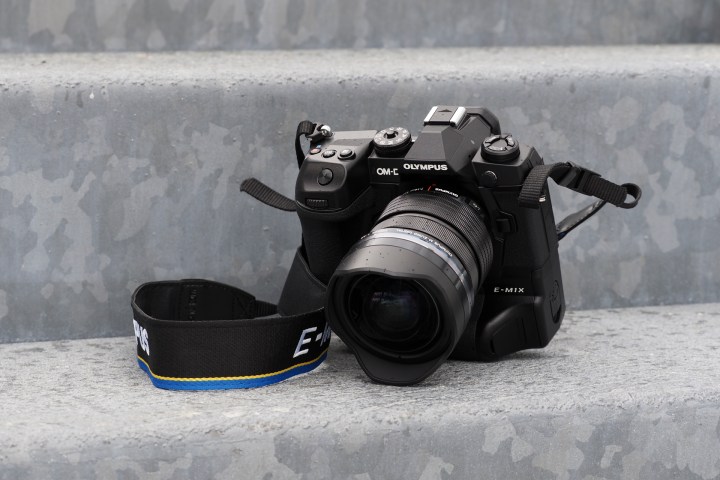
The reason for the advent of the mirrorless camera is right in the name — the rise of digital photography meant the mirror and associated optical viewfinder of an SLR was no longer necessary, and cameras could be made smaller and lighter without it while still offering the flexibility of interchangeable lenses. Mirrorless cameras entered the world as the pint-sized, beginner-friendly alternatives to big and complex DSLRs, but a decade later, they’ve earned clout with enthusiasts and professionals and taken over the role of the DSLR in many cases. So is mirrorless still about making cameras lighter and smaller? Looking at some of the latest models, the answer would appear to be no.
Take the recently launched Olympus OM-D E-M1X, a $3,000 flagship mirrorless camera targeting professional photographers. While packing in a relatively small Four Thirds sensor, the body features an integrated vertical grip that puts it in league with the largest DSLRs like the Nikon D5 and Canon EOS-1D X Mark II that use much larger full-frame sensors.
The mirrorless cameras that the pros are more likely to pick up are often significantly heavier
The body alone weighs more than two pounds, which is more than half a pound heavier than Sony’s full-frame, sports-focused mirrorless camera, the A9. In fact, the E-M1X weighs more than full-frame DSLRs without integrated vertical grips, like the Nikon D850. Olympus says the focus of the new body design is durability and performance, things professional shooters look for. And the smaller sensor does grant one advantage: Smaller lenses, and, therefore, an overall smaller package than an equivalent full-frame system.
Even within the same series, some mirrorless cameras have been slowly packing on the ounces. The Sony A7R III is roughly seven ounces heavier than the original A7R, but now sports better build quality and weather sealing. The Panasonic Lumix GH5 is more than five ounces heavier than the Lumix GH4. The weight gain isn’t universal: Some models, like the Fujifilm X-T20 and X-T30, weigh nearly exactly the same from generation to generation, but many others have grown in both size and weight as manufacturers build in more features and seek to appeal to higher-end customers.

To be fair, DSLRs still tend to be heavier than mirrorless cameras, in general. The Nikon Z7 weighs 20.7 ounces while the DSLR with the most similar features, the D850, weighs 32.3 ounces. That’s not always the case, however. Panasonic’s new S1 and S1R full-frame mirrorless cameras weigh about 36 ounces with the battery and memory card loaded.
Examining these heavier models offers insight into why newer models don’t necessarily stick with the same recipe as their lighter weight forebears. The trend towards heavier mirrorless cameras follows the trend toward higher-end models and away from consumer-oriented ones.
Mirrorless is pushing photography forward with the latest technology at the expense of its physical footprints.
The mirrorless cameras that the pros are more likely to pick up are often significantly heavier thanks to better build quality, bigger grips for improved ergonomics, larger viewfinders, and more physical controls. And with casual photographers ever more likely to simply shoot on their phones, camera makers are putting less emphasis on the lower end of the market where compact mirrorless cameras would make the most sense.
“Lightweight” and “compact” may no longer be part of the main marketing speak used to sell mirrorless cameras, but that’s not to say all manufacturers are neglecting customers looking for a slimmed-down system, The aforementioned Fujifilm X-T30 weighs just 13.5 ounces, and even the more advanced X-T3 is just 19.

At a hair over 17 ounces, Canon’s just-announced EOS RP is the lightest and most compact new full-frame camera on the market (it’s also the cheapest, at $1,299). But the RP ditches several features found in more advanced mirrorless cameras, including in-body image stabilization and professional-level weather sealing. It also makes do with a smaller battery and viewfinder.
But the mirrorless cameras pushing photography forward with the latest technology no longer seem to care about about their physical footprints. Manufacturers aren’t choosing to adopt mirrorless because it’s smaller, but simply because it’s better. The trade-off is more advanced features that most photographers are happy to have. Build quality and weather-sealing is improving. Stabilization is moving from the lenses to the body (in some cases). Batteries are getting bigger. Electronic viewfinders are growing larger. Control schemes are favoring more physical buttons and dials, while beefier handgrips mean added comfort even with the extra weight.
When does the extra weight become a bigger con over the pros of added features and improved quality?
And this trend isn’t exclusive to just camera bodies. A recent study by Photography Life suggests that the average weight of all new camera lenses — DSLR and mirrorless included — have increased since around 2013. We’ve seen this even in traditionally very compact focal lengths, such as 50mm primes — the Pentax Star-series 50mm f/1.4 weighs 2 pounds, over four times as heavy as the older Normal 50mm f/1.4.
Even the average weight of Micro Four Thirds lenses, which are still praised for their compactness, has increased. As with cameras, this increase in lens size is a result of a shift toward higher-end designs, with improved optics to meet the demands of today’s high-resolution image sensors.
With the increase in full-frame mirrorless production (three companies have joined the fray in the past 6 months), lenses are likewise not getting any smaller — for the most part. The Nikon Z-mount 50mm f/1.8 and 35mm f/1.8 lenses are heavier than their F-mount counterparts for DSLRs, but the upcoming Z 24-70mm f/2.8 is lighter and smaller (partially thanks to not including image stabilization, which Nikon Z cameras have in the body).

Canon’s 24-105mm f/4 is slightly heavier for the mirrorless RF mount compared to its EF-mount cousin for DSLRs, and the RF 50mm f/1.2 prime is also heavier than the EF version. Canon did show off an upcoming RF 70-200mm f/2.8 recently that is considerably shorter than the EF version.
The question is — when does the extra weight become a bigger con over the pros of added features and improved quality? It seems many companies are racing to see who can reach that high point first, but cameras like the Canon EOS RP may yet prove there’s still demand for lightweight alternatives. For now, if you’re in the market for a lightweight camera, don’t make the assumption that mirrorless is your best bet — read that spec sheet first.




